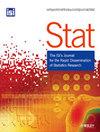STAR: Spread of innovations on graph structures with the Susceptible‐Tattler‐Adopter‐Removed model
IF 0.8
4区 数学
Q3 STATISTICS & PROBABILITY
引用次数: 0
Abstract
Adoptions of a new innovation such as a product, service or idea are typically driven both by peer‐to‐peer social interactions and by external influence. Social graphs are usually used to efficiently model the peer‐to‐peer interactions, where new adopters influence their peers to also adopt the innovation. However, the influence to adopt may also spread through individuals close to the adopters, known as tattlers, who only share information regarding the innovation. We extend an inhomogeneous Poisson process model accounting for both external and peer‐to‐peer influence to include an optional tattling stage, and we term the extension the Susceptible‐Tattler‐Adopter‐Removed (STAR) model. In an extensive simulation study, the proposed model is shown to be stable and identifiable and to accurately identify tattling when present. Further, using simulations, we show that both inference and prediction of the STAR model are quite robust against missing edges in the social graph, a common situation in real‐world data. Simulations and theoretical considerations demonstrate that, when edges are missing, the STAR model is able to accurately estimate the shares attributed to the external and internal sources of influence. Furthermore, the STAR model may be used to improve the inference of the external and viral parameters and subsequent predictions even when tattling is not part of the real data‐generating mechanism.STAR:利用 "易受攻击者--攻击者--被攻击者--被移除者 "模型在图结构上传播创新成果
产品、服务或理念等新创新的采用通常是由点对点的社会互动和外部影响共同推动的。社交图谱通常用于有效地模拟点对点互动,即新采用者影响其同伴也采用创新。然而,采用创新的影响也可能通过与采用者关系密切的个体传播,这些个体被称为 "吹捧者",他们只分享有关创新的信息。我们扩展了一个非均质泊松过程模型,将外部影响和同伴间影响都考虑在内,并加入了一个可选的 "吹捧 "阶段,我们将这一扩展称为 "易受影响者--吹捧者--被吹捧者"(STAR)模型。在一项广泛的模拟研究中,我们发现所提出的模型是稳定的、可识别的,并能在出现 "吐槽 "的情况下准确识别 "吐槽"。此外,通过模拟,我们还证明了 STAR 模型的推理和预测对社交图中的缺失边(这是真实世界数据中常见的情况)具有很强的鲁棒性。模拟和理论分析表明,当边缘缺失时,STAR 模型能够准确估计外部和内部影响源所占的份额。此外,STAR 模型还可用于改进外部参数和病毒参数的推断以及后续预测,即使 "告密 "并不是真实数据生成机制的一部分。
本文章由计算机程序翻译,如有差异,请以英文原文为准。
求助全文
约1分钟内获得全文
求助全文
来源期刊

Stat
Decision Sciences-Statistics, Probability and Uncertainty
CiteScore
1.10
自引率
0.00%
发文量
85
期刊介绍:
Stat is an innovative electronic journal for the rapid publication of novel and topical research results, publishing compact articles of the highest quality in all areas of statistical endeavour. Its purpose is to provide a means of rapid sharing of important new theoretical, methodological and applied research. Stat is a joint venture between the International Statistical Institute and Wiley-Blackwell.
Stat is characterised by:
• Speed - a high-quality review process that aims to reach a decision within 20 days of submission.
• Concision - a maximum article length of 10 pages of text, not including references.
• Supporting materials - inclusion of electronic supporting materials including graphs, video, software, data and images.
• Scope - addresses all areas of statistics and interdisciplinary areas.
Stat is a scientific journal for the international community of statisticians and researchers and practitioners in allied quantitative disciplines.
 求助内容:
求助内容: 应助结果提醒方式:
应助结果提醒方式:


